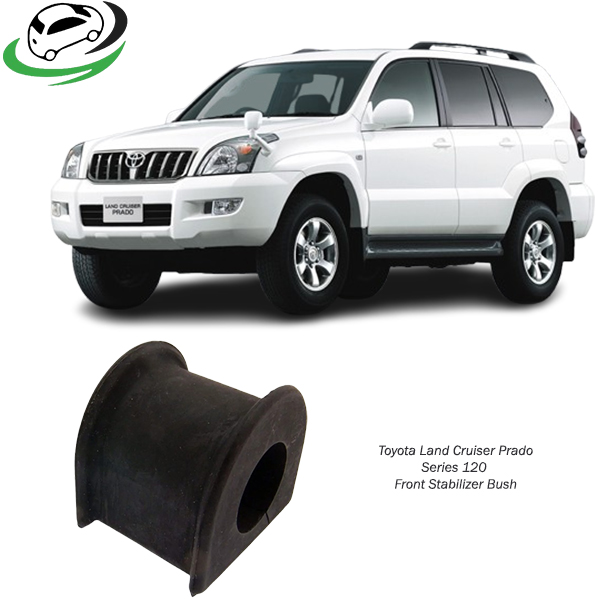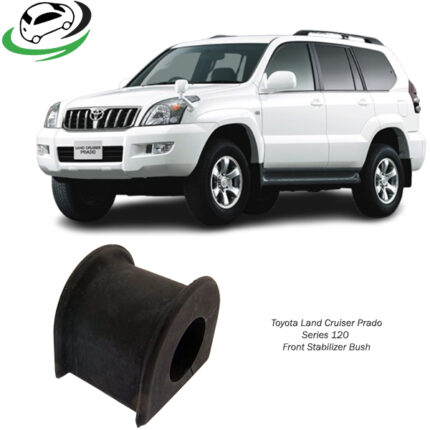Get Toyota Land Cruiser Prado 120 Series Front Stabilizer Bush 48815-60350
The front stabilizer bush, also known as the sway bar bushing, is a critical yet often overlooked component of a vehicle’s suspension system. It plays an essential role in ensuring ride comfort, stability, and vehicle control, especially when navigating corners, bumps, or uneven surfaces. This detailed explanation will cover the function, benefits, and maintenance tips related to front stabilizer bushes, helping you understand their importance in vehicle performance and safety.
Function of the Front Stabilizer Bush
The front stabilizer bush is part of the vehicle’s anti-roll bar system, also known as a sway bar or stabilizer bar. This bar is designed to reduce body roll when a vehicle is turning or cornering. The stabilizer bush acts as a cushion between the anti-roll bar and the chassis of the vehicle. It isolates the sway bar from the suspension system, preventing metal-to-metal contact and reducing noise and vibration. Here’s how the entire system works:
- Stabilizing the Vehicle during Turns: When a car turns, the body tends to lean or roll to one side due to centrifugal force. The front stabilizer bush works with the stabilizer bar to reduce this roll, distributing the weight more evenly across all four wheels. This not only enhances vehicle stability but also improves handling, particularly in tight turns or evasive maneuvers.
- Damping Vibration and Noise: The bushings act as insulators, absorbing road vibrations and minimizing the transmission of noise to the cabin. Without stabilizer bushes, the stabilizer bar would make direct contact with the vehicle’s frame, leading to clunks, squeaks, and an uncomfortable ride.
- Protecting Suspension Components: The front stabilizer bushes protect both the anti-roll bar and the surrounding suspension components from premature wear and tear. By absorbing movement, these bushes prevent excessive force from being transferred to other parts of the suspension system.
- Ensuring Proper Alignment: Front stabilizer bushes help in maintaining proper wheel alignment. They ensure that the stabilizer bar remains securely in position, allowing the suspension to work as intended. When these bushes wear out, it can result in misalignment and uneven tire wear.
Types of Stabilizer Bushes
There are generally two main types of front stabilizer bushes based on the material they are made of:
- Rubber Bushes: These are the most common and provide a good balance between comfort and performance. Rubber bushes are known for their flexibility and ability to absorb vibrations effectively, ensuring a smoother ride. However, rubber deteriorates over time, especially when exposed to heat, oil, and road contaminants. Rubber bushes are ideal for drivers who prioritize comfort over aggressive handling.
- Polyurethane (PU) Bushes: Polyurethane bushes are stiffer and more durable than rubber. They are resistant to chemicals, heat, and general wear and tear, making them last longer. These bushes provide more precise handling, which is favored by performance-oriented drivers. However, PU bushes can transmit more road noise and vibration into the cabin due to their stiffness, making them less ideal for drivers who prioritize comfort.
Benefits of Front Stabilizer Bushes
The front stabilizer bush provides several benefits to the overall suspension and handling characteristics of a vehicle. Here are some key advantages:
- Enhanced Stability: The primary benefit of the front stabilizer bush is the improved stability it offers, especially during cornering. By reducing body roll, it ensures that the car remains level and well-balanced, which increases the driver’s control over the vehicle.
- Better Handling: Stabilizer bushes contribute to more responsive and predictable handling, particularly during high-speed turns or abrupt steering maneuvers. This improvement in handling can be crucial for both everyday driving and emergency situations where quick reactions are needed.
- Improved Ride Comfort: By isolating vibrations from the stabilizer bar and absorbing some of the road shock, these bushes enhance ride comfort. They help in minimizing jolts and impacts felt by passengers when driving over uneven roads or potholes.
- Extended Suspension Lifespan: By reducing wear and tear on the stabilizer bar and the surrounding suspension components, stabilizer bushes help extend the life of the suspension system. This can lead to fewer costly repairs over the long term.
- Noise Reduction: When in good condition, front stabilizer bushes help minimize clunking noises and vibrations, leading to a quieter and more comfortable cabin environment.
- Cost-Effective Solution: Front stabilizer bushes are relatively inexpensive compared to other suspension components, but their role in maintaining vehicle performance is significant. Replacing worn bushes can rejuvenate the vehicle’s handling and comfort at a fraction of the cost of more extensive suspension repairs.
Signs of Worn Front Stabilizer Bushes
Like all vehicle components, front stabilizer bushes wear out over time due to constant stress, friction, and environmental exposure. Here are some common signs that indicate the bushes may need to be replaced:
- Clunking Noises: A worn or damaged stabilizer bush often results in a clunking or knocking noise, particularly when driving over bumps or uneven roads. This noise is caused by the stabilizer bar making contact with the vehicle’s frame.
- Excessive Body Roll: If you notice that your car leans excessively to one side when turning, it may be due to worn stabilizer bushes. The reduced effectiveness of the bushings allows more movement in the stabilizer bar, leading to greater body roll.
- Poor Handling: A decrease in handling performance, such as slower response during turns or reduced steering precision, can be a sign that the stabilizer bushes are worn out. The loss of rigidity in the system affects how the vehicle responds to driver inputs.
- Uneven Tire Wear: While this can be caused by a variety of suspension issues, worn stabilizer bushes may contribute to uneven tire wear by allowing more movement in the suspension components, which affects alignment.
- Visible Damage: Upon inspection, worn stabilizer bushes may appear cracked, brittle, or even deformed. Oil leaks or contamination can also deteriorate rubber bushes, making them less effective.
Maintenance Tips for Front Stabilizer Bushes
Proper maintenance of front stabilizer bushes can prolong their life and ensure optimal vehicle performance. Here are some tips to keep them in good condition:
- Regular Inspections: Periodically inspect the front stabilizer bushes for signs of wear or damage. Look for cracks, deformation, or signs of rubber deterioration, especially in older vehicles or those frequently exposed to harsh driving conditions.
- Lubrication: For polyurethane bushes, applying a suitable lubricant can help prevent squeaking and ensure smooth movement. Rubber bushes generally don’t require lubrication, but it’s essential to keep them free from oil and contaminants that can accelerate wear.
- Timely Replacement: Don’t wait for the bushes to completely fail before replacing them. If you notice any of the warning signs, it’s best to replace the stabilizer bushes promptly to avoid further damage to the suspension system.
- Professional Inspection During Service: Ask your mechanic to check the condition of the front stabilizer bushes during routine servicing or whenever the suspension system is being worked on. Early detection of worn bushes can save you from more expensive repairs down the line.
- Avoid Overloading the Vehicle: Overloading a vehicle places additional stress on the suspension components, including the stabilizer bushes. Adhering to the manufacturer’s load limits can help reduce wear on these bushes.
Conclusion
Front stabilizer bushes are essential components of a vehicle’s suspension system, providing improved stability, handling, and ride comfort. Although small and often inexpensive, their impact on vehicle performance is significant. Regular inspections, timely replacements, and proper maintenance of stabilizer bushes will ensure that your vehicle remains safe, comfortable, and easy to handle on the road. Whether you’re a casual driver or an enthusiast, paying attention to the condition of your stabilizer bushes is key to maintaining a well-performing vehicle.
Follow us on Facebook for more parts.




